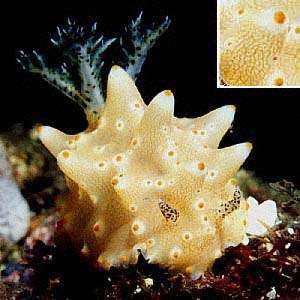
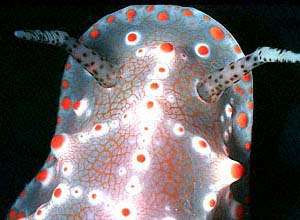
Halgerda batangas
Carlson & Hoff, 2000
Order: NUDIBRANCHIA
Suborder: DORIDINA
Family: Dorididae
DISTRIBUTION
Tropical Western Pacific.
PHOTO
UPPER: Housereef, Lipayo, Negros Is., Philippines, November 1998. PHOTO: Erwin Koehler.
LOWER: 40mm, Philippines, Batangas, Anilao,
12m, 22 April 1998. Collected by Debbie Fugitt. PHOTO: Clay Carlson.
One of a group of white species of Halgerda with orange markings. This species is characterised by tubercles with an orange-red tip and a mantle colour pattern consisting of a network of solid red-orange lines. There is a white band around the mantle edge containing low rounded orange-capped tubercles. The mantle tubercles range in size from low rounded bumps to tall prominent structures. The small tubercles have an orange-red tip and a basal ring of white. The large tubercles are tipped wih orange-red and have a broad subterminal white band. Beneath the white band the sides of the large tubercles have the reticulate pattern found on the mantle.
There are three species of Halgerda with a network of orange lines. In H. malesso the network of lines sometimes fuse to form orange patches in the depressions, there are multiple fine orange lines around the mantle edge, and the fairly high tubercles are capped with orange. In Halgerda batangas, which also has a network of orange lines, the ridges and tubercles are low and rounded. The tubercles are capped with orange-red and have a basal ring of white. The edge of the mantle is white with orange-red tubercles. The foot is edged with orange. The third species with an orange network is Halgerda terramtuentis. It has golden orange lines and the tubercles are capped with white.
Other similar coloured species include Halgerda carlsoni and Halgerda aurantiomaculata.
Reference:
• Bertsch, H. & Johnson, S. (1982) Three new species of dorid nudibranchs (Gastropoda: Opisthobranchia) from the Hawaiian Islands. The Veliger, 24(3): 208-218.
• Carlson, C.H. & Hoff, P.J. (1993) Three new Halgerda species (Doridoidea: Nudibranchia: Opisthobranchia) from Guam. The Veliger, 36(1): 16-26.
• Carlson, C.H. & Hoff, P.J. (2000) Three new Pacific species of Halgerda (Opisthobranchia: : Nudibranchia: Doridoidea). The Veliger, 43(2): 154-163.
See Clay Carlson's February 5, 1999 message comparing this species with H. malesso.
Note: Until 25 June 2000, this species was Halgerda sp. 1 on the Forum
Authorship detailsRudman, W.B., 1999 (February 3) Halgerda batangas Carlson & Hoff, 2000. [In] Sea Slug Forum. Australian Museum, Sydney. Available from http://www.seaslugforum.net/find/halgbata
Related messages
Colour variation in Halgerda batangas
October 1, 2008
From: Marcel Tanke
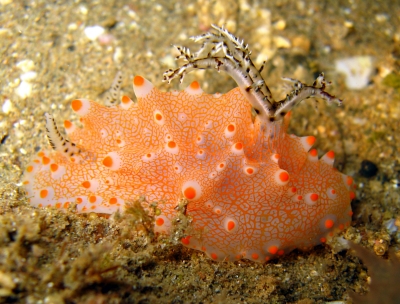
Concerning message #21570:
Dear Bill,
Both pictures attached show, I think, Halgerda batangas. The one in the first picture (Anilao, Philippines, July 2008) shows a fine mazed network of red lines on its mantle. The second one (Lembeh Strait, Indonesia, February 2007) has more parallel red lines.
Best regards,
Marcel
marceltanke@cs.com
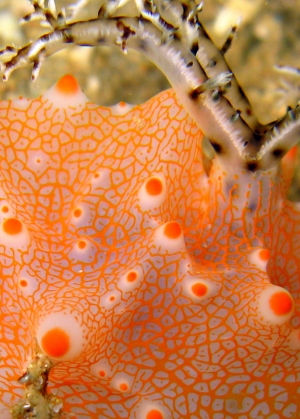
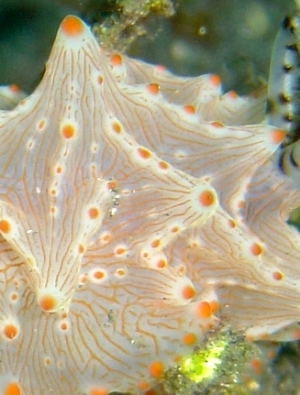
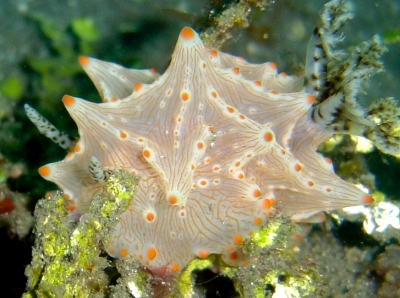
Dear Marcel,
I agree that these are most probably forms of H. batangas. See my comments in message #19119 which has similar variations. Although we don't have actual specimens to compare, photos like yours give us valuable information on the range of colour pattern to be found. Although the extremes of the colour pattern, as illustrated in your two animals, might suggest two species, the intermediates we now have on the Forum, suggest otherwise. In fact the photo in your message #21916 shows lines on the rather elongate tubercles and a network in the spaces.
Best wishes,
Bill Rudman
Halgerda batangas from Indonesia
October 1, 2008
From: Marcel Tanke
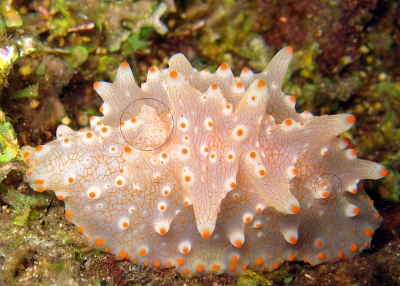
Concerning message #21570:
Dear Bill,
Is this Halgerda batangas? It has completely withdrawn its rhinophores (one in the smaller circle) and gills (in the larger circle). It has some large tubercles.
Locality: Tulamben, Bali, 15 m, Indonesia, 9 October 2007. Length: about 5 cm. Photographer: Marcel Tanke.
Best regards,
Marcel
marceltanke@cs.com
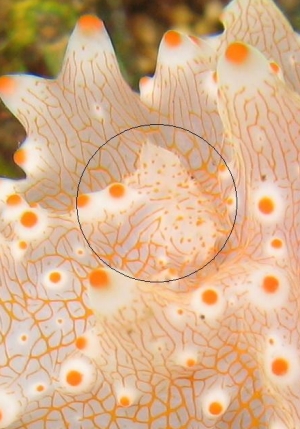
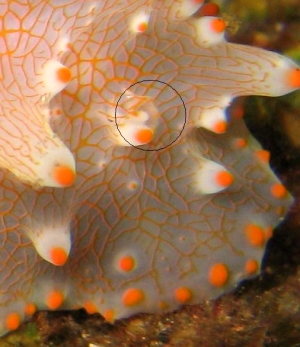
Dear Marcel,
Yes this is H. batangas.
Best wishes,
Bill Rudman
Halgerda batangas from Southern Leyte, Philippines
September 19, 2008
From: Carrie Lo
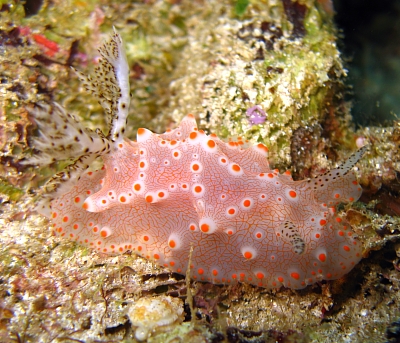
Dear Bill,
I believe this is also a Halgerda malesso, although in a different color.
Locality: Bunga Bend South, Southern Leyte, 15 m, Philippines, 24 Dec 2008. Length: 2.5 inch. Photographer: Carrie Lo.
Regards,
Carrie
carrielohc@yahoo.com.hk
Lo, C., 2008 (Sep 19) Halgerda batangas from Southern Leyte, Philippines. [Message in] Sea Slug Forum. Australian Museum, Sydney. Available from http://www.seaslugforum.net/find/21570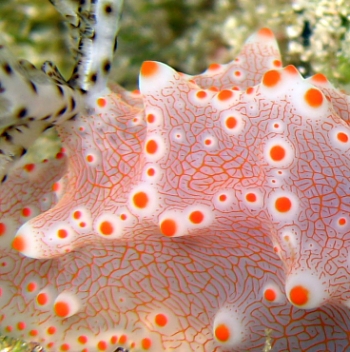
Dear Carrie,
This is H. batangas. If you look at the species Fact Sheet, you will see the differences between these species discussed.
Best wishes,
Bill Rudman
Re: Halgerda batangas from the Solomon Ids
September 2, 2008
From: Barbara Hanchard
Concerning message #21833:
Dear Bill,
Well I had a good laugh at your reply and do feel quite stupid. I did find the position of the opening odd but never considered that it was the anus and that the animal was defecating having never seen its egg ribbon. Color variation of the pellets between the two photos (taken within minutes of each other of the same animal) are simply differences between camera and strobes.
Barbara
barbara.hanchard@ffa.int
Hanchard, N.B., 2008 (Sep 2) Re: Halgerda batangas from the Solomon Ids. [Message in] Sea Slug Forum. Australian Museum, Sydney. Available from http://www.seaslugforum.net/find/21847Dear Barbara,
No need to feel stupid - even for a millisecond. There is no point in asking only those questions you already know the answer to - and hopefully a lot of others learnt something new as well. Concerning the colour of the faecal pellets in the two photos - You mentioned two animals so I assumed you had each photographed different ones. I must admit I thought it a bit of a co-incidence that they both needed relief at the same time.
Best wishes,
Bill Rudman
Halgerda batangas from the Solomon Ids
August 29, 2008
From: Barbara Hanchard
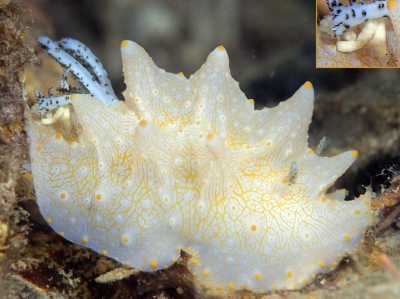
Hi Bill,
A joint submission by myself and Tamara Hartwich. Tamara's photo actually shows the egg ribbon bundled around the back of this Halgerda batangas and on my photo [upper ] you can actually see the secretion area beside the gills. I haven't looked through all the entries for this species on the Forum to see if egg laying has been covered in this species and I apologise if this entry is repetitious. This guy was one of two found within a meter of each other. Both very large (90 mm & 50 mm respectively) and probably the largest I have seen here in the Solomon Islands.
Locality: Tulagi Harbour, USS Minniapolis, 13 meters, Florida Islands, Solomon Islands, Pacific Ocean, 24 August 2008, Muddy slope. Length: 90mm. Photographer: Upper Photo: N.Barbara Hanchard ; Lower Photos: Tamara Hartwich.
Regards,
Barbara Hanchard & Tamara Hartwich
barbara.hanchard@ffa.int
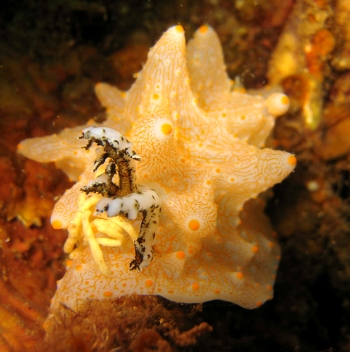
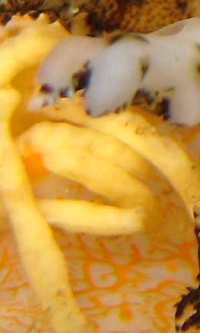
Dear Barbara & Tamara,
I am afraid these animals are engaged in a bodily function which is not quite as romantic as egg-laying, but equally important. The white pellets in your photo and the yellow ones in Tamara's, are faecal pellets. In sponge-eating dorids the colour of the faeces is usually identical to that of the sponge they are feeding on. I may be quite wrong but there appears to be a white sponge at the front of your animal and yellow sponge just in front of Tamara's photo.
You might ask why the anus is found right in the centre of the circle of gills in dorids - it may seem wrong to have faeces so close to the delicate breathing apparatus. The close proximity of the gills and the anus is a leftover from the evolutionary past when slugs were shelled snails, and the gill, anus and kidney opened together in the mantle cavity. As the shape of the slug evolved, and the position of body openings changed, the anus, for some unknown reason, has retained a close link to the gill.
Best wishes,
Bill Rudman
Halgerda batangas from Mabul
April 18, 2008
From: Kenneth Yong
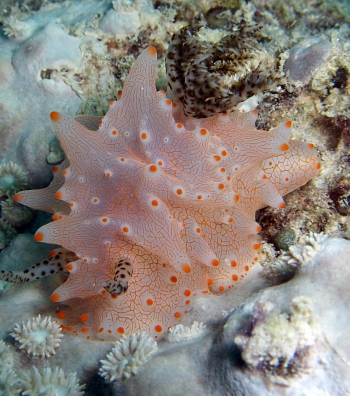
Dear Bill,
Is this Halgerda batangas? Unfortunately the dive guide moved from its original position so I can't tell you what substrate it was actually on.
Locality: Mabul Island, Paradise 2 divesite, 6 m, Sabah, Malaysia, Celebes Sea, 19 July 2007. Length: 7-8 cm. Photographer: Kenneth Yong.
Thanks much.
Cordially,
Kenneth
kyong67@tiscali.it
Yong, K., 2008 (Apr 18) Halgerda batangas from Mabul. [Message in] Sea Slug Forum. Australian Museum, Sydney. Available from http://www.seaslugforum.net/find/20619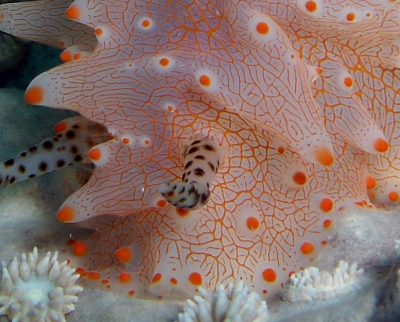
Dear Kenneth,
Yes this is H. batangas. It is unfortunate if dive guides are moving animals like this. Apart from leading to misleading photos it can be damaging to the nudibranch. Many encrusting colonial animals have defensive mechanisms such as secretions and stinging cells to deter other from settling on, or even just crawling over the colony. I have even found that putting the coral-eating aeolid Phestilla lugubris (which eats species of Porites), on the wrong species of Porites, will cause it to react violently, curling up and rolling off the colony. So if you plonk a slug down on a colonial animal it doesn't react well to it can be badly stung, poisoned or even just roll off and get washed away from its food source. If an animal is squeezed into a crevice or for some other reason you need to move it to photograph it, be careful to place it on a bit of dead rock or other inanimate object.
Best wishes,
Bill Rudman
Halgerda batangas from New Britain
July 3, 2007
From: Tony Armstrong
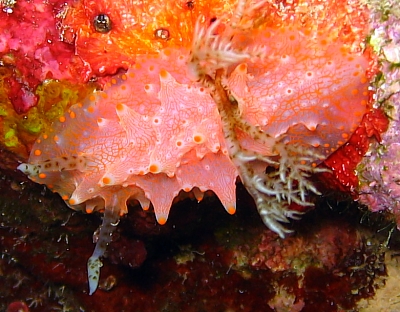
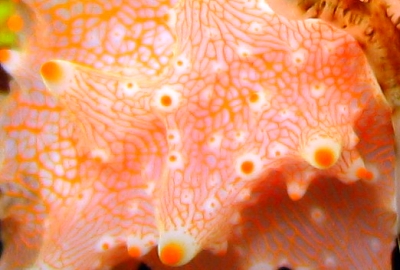
I found this nudibranch in 7 to 8 metres of open ocean reef, north facing, approx 3 km north of Wide Bay (west of Rabaul) on New Britain, Papua New Guinea.
Locality: Kabaira, 7 metres, New Britian, Wide Bay, 02 January 2007, Open reef. Length: 65 mm. Photographer: Tony Armstrong.
I've checked a couple of books with a few nears but nothing that close for identification. It is a first for me.
Any ideas?
Thanks
Tony
tony1armstrong@bigpond.com
Armstrong, A., 2007 (Jul 3) Halgerda batangas from New Britain. [Message in] Sea Slug Forum. Australian Museum, Sydney. Available from http://www.seaslugforum.net/find/19578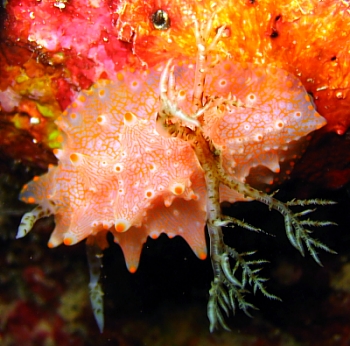
Dear Tony,
After the chromodorids, the genus Halgerda contains some of the most spectacularly coloured sponge-feeding dorids. This is Halgerda batangas.
Best wishes,
Bill Rudman
Halgerda batangas from the davao gulf
May 22, 2007
From: Carlos R. Munda
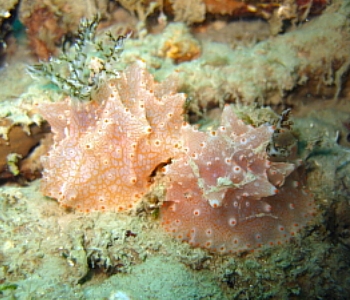
Dear Bill,
Here are some specimen photos for your file of a couple of Halgerda batangas taken along the coast of Samal island in the Davao gulf.
Locality: Samal island, 15-20 feet, Philippines, Davao gulf , December 2006, muddy. Length: approx 1 inch. Photographer: Carlos r. munda, jr..
Carlos R. Munda, Jr.
c_munda@yahoo.com
Munda, C., 2007 (May 22) Halgerda batangas from the davao gulf. [Message in] Sea Slug Forum. Australian Museum, Sydney. Available from http://www.seaslugforum.net/find/19143Thanks Carlos,
Bill Rudman
Rudman, W.B., 2007 (May 22). Comment on Halgerda batangas from the davao gulf by Carlos R. Munda. [Message in] Sea Slug Forum. Australian Museum, Sydney. Available from http://www.seaslugforum.net/find/19143Is this Halgerda malesso?
May 18, 2007
From: Mirjam Broos
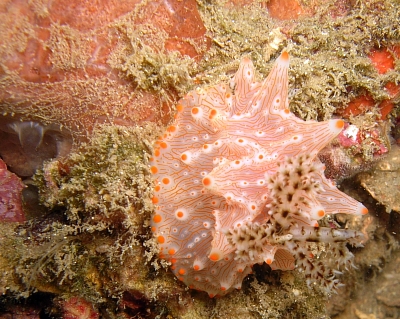
Dear Bill,
Is this Halgerda malesso?
I think the forum is great and I appriciate your help very much. Identification is really hard for a beginner.
Locality: Paradise Jetty, Likupang, North Sulawesi, Indonesia, 07 October 2006. Photographer: Geert Prast.
Mirjam Broos
mirjam.broos@planet.nl
Broos, M, 2007 (May 18) Is this Halgerda malesso?. [Message in] Sea Slug Forum. Australian Museum, Sydney. Available from http://www.seaslugforum.net/find/19119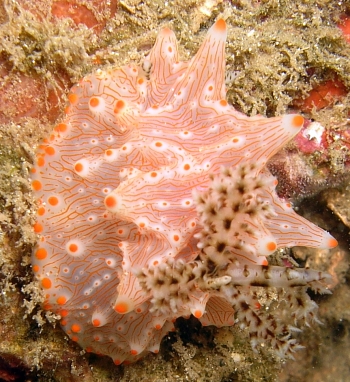
Dear Mirjam,
Quite a few species of Halgerda have been described in recent years and it will take a while, as new colour forms and variations are found, to work our whether the 'new' species are all valid or whether a few modifications will need to be made. This is normal practice when a revision of a group occurs because it is almost ipossible to get it all right first time around. Your animal is similar to the one in Erwin Kodiat's recent message [#19588] which I have identified as Halgerda batangas, although in both that species and H. malesso the orange lines are supposed to form a network pattern rather than the parallel lines found in your animal.
Best wishes,
Bill Rudman
Halgerda batangas from Raja Ampat, Indoneisa
April 5, 2007
From: Erwin Kodiat
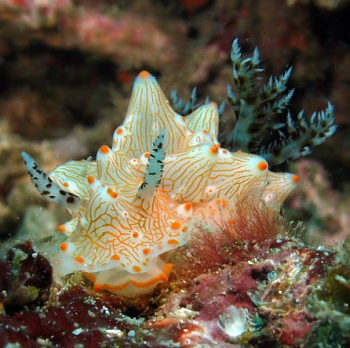
Hi Bill,
Found this in Raja Ampat Islands, however I am confused whether this one is Halgerda batangas, Halgerda malesso or Halgerda carlsoni.
Locality: Raja Ampat Islands, 20 metres, Indonesia, Pacific Sea, 18 February 2007, Coral reef. Length: 30 mm. Photographer: Erwin Kodiat.
Can you help me ID this?
Thanks
Erwin Kodiat
nudibranch@kapalselam.org
Kodiat, E., 2007 (Apr 5) Halgerda batangas from Raja Ampat, Indoneisa. [Message in] Sea Slug Forum. Australian Museum, Sydney. Available from http://www.seaslugforum.net/find/19588Dear Erwin,
I am pretty sure this is H. batangas, although the orange lines on the tubercles are arranged in parallel lines rather than as a network. Halgerda malesso is similar in colour but has submarginal orange lines around the mantle edge and H. carlsoni has spots rather than lines.
Best wishes,
Bill Rudman
Halgerda batangas from Sipadan Island, Malaysia
June 13, 2006
From: Charles Rowe
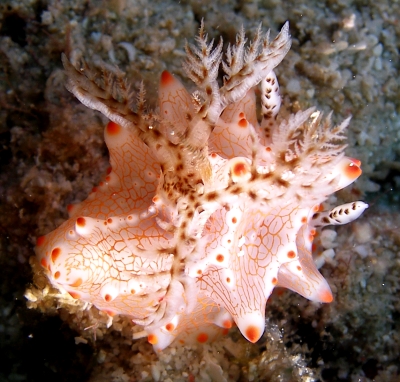
Hi Bill,
This is the first of a series of nidis from my trip to Sipadan which I would like you to identify and comment on.
Locality: Sipadan Island, 15 metres, Malaysia, 27 April 2006, sandy bottom. Length: 1.5 inches. Photographer: Charles Rowe.
Charles Rowe
bumff@mweb.co.za
Charles Rowe, 2006 (Jun 13) Halgerda batangas from Sipadan Island, Malaysia. [Message in] Sea Slug Forum. Australian Museum, Sydney. Available from http://www.seaslugforum.net/find/16834Dear Charles,
Form the distinctive colour pattern, this is Halgerda batangas.
Best wishes,
Bill Rudman
Halgerda batangas from Papua New Guinea
February 28, 2006
From: Kawika Chetron
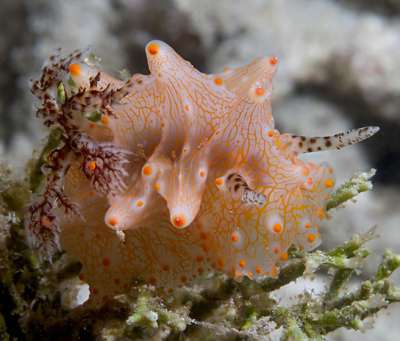
Hi All,
This is some Halgerda that Clinton Bauder pointed out to me during a night dive in New Guinea last summer. It ended up being easily my best slug picture from trip, so, I thought I'd share.
Locality: Wewak/Madang area, Oh, maybe 35 ft or so., Papua New Guinea, Bismark Sea, 19 August 2005, Sandy slope. Length: About 2 cm. Photographer: Kawika Chetron.
Oh, if anyone wants to venture a guess about the exact species, I'm all ears.
Cheers,
Kawika
kawika@sbcglobal.com
Chetron, K. D. B., 2006 (Feb 28) Halgerda batangas from Papua New Guinea. [Message in] Sea Slug Forum. Australian Museum, Sydney. Available from http://www.seaslugforum.net/find/15950Dear Kawika,
It is a nice photo. The slugs is Halgerda batangas, one of many species with orange markings.
Best wishes,
Bill Rudman
Re: Halgerda batangas from the Philippines
December 10, 2003
From: Asther M. Lau
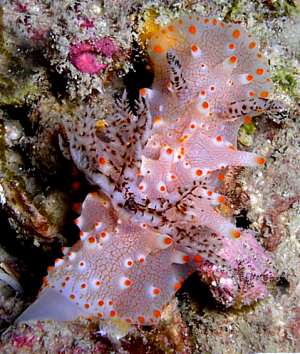
Dear Bill,
My buddy, Lim Eng Hoo took these pics of what I think is Halgerda batangas. I found it at Pinnacle II, Dayang Is. near Johor, Malaysia.
I was so thrilled with this finding. It was crawling on little rocks and dead corals. Very camouflaged at far distance.
Site: Pinnacle II, Dayang/Aur Islands, Johor, Malaysia
Date: 17th May 2003
Depth: 16m
This is my first Halgerda. Am so amazed at how camouflaged it was on the broken stones and sand. But when I got nearer, I realised it was of pinkish/orange color. It was crawling slowly and doesn't seem to go anywhere particular. After spending near 15 mins with it, we continued our dive so as not to bore the rest of the divers who were waiting for us.
What beautiful creature it is.
Best Wishes
Asther M. Lau
alau425@hotmail.com
Lau, A.M., 2003 (Dec 10) Re: Halgerda batangas from the Philippines. [Message in] Sea Slug Forum. Australian Museum, Sydney. Available from http://www.seaslugforum.net/find/11636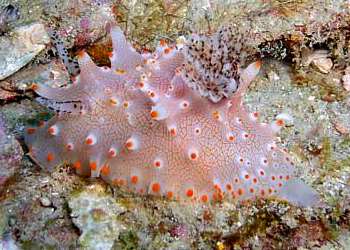
Dear Asther,
Yes this is Halgerda batangas. It is amazing how some of the most brilliantly coloured animals are in fact very well camouflaged when they are in their natural surroundings.
Best wishes
Bill Rudman
Halgerda batangas from the Philippines
August 13, 2003
From: Erwin Köhler
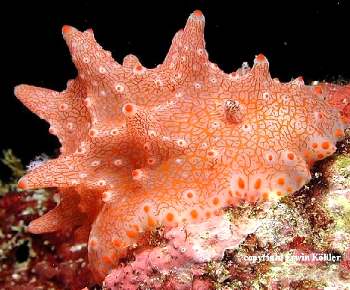
Dear Bill,
You write on the Fact Sheet "This species is characterised by relatively low rounded orange-red tipped tubercles..." Here is one from the Philippines, Cebu island, Moalboal, divesite Pescador with large tubercles.
data
length: 48mm
depth: 13m
date 13 March 2002
Cheers Erwin
www.Philippine-Sea-Slugs.com
Erwin@Philippine-Sea-Slugs.com
Köhler, E., 2003 (Aug 13) Halgerda batangas from the Philippines. [Message in] Sea Slug Forum. Australian Museum, Sydney. Available from http://www.seaslugforum.net/find/10700Dear Erwin,
I did indeed write 'low rounded .. tubercles' - but when I wrote that we didn't have the wealth of photos and information on the species that we do now. It would seem in fact that animals with high pointed tubercles are the common form. I will change the Fact Sheet.
Thanks,
Bill Rudman
Halgerda batangas from Malaysia
August 8, 2003
From: Francis & Pirjo Pellet
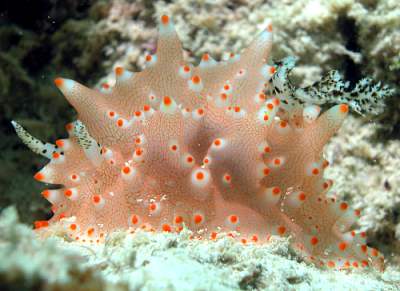
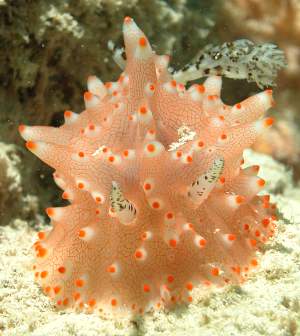
Dear Bill,
To accompany my other message, we found this Halgerda in Kapalai, Malaysia, the 22nd of May 2003 . Dive site "Mantis Ground", depth 14m. Is this Halgerda batangas [Length 7 cm). You can clearly see the orange network between the tubercles. Thank you for your identification.
Best regards.
Francis and Pirjo.
pirjo.pellet@free..fr
Pellet, F. & P., 2003 (Aug 8) Halgerda batangas from Malaysia. [Message in] Sea Slug Forum. Australian Museum, Sydney. Available from http://www.seaslugforum.net/find/10580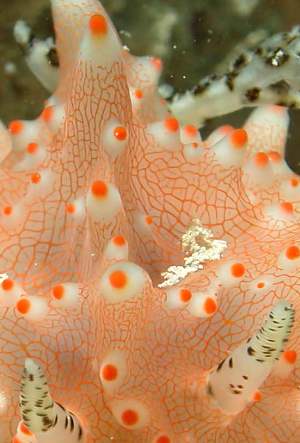
Dear Francis & Pirjo,
The orange network clearly identifies this as Halgerda batangas.
Best wishes,
Bill Rudman
Halgerda batangas from Indonesia
September 19, 2002
From: Sabine Noack
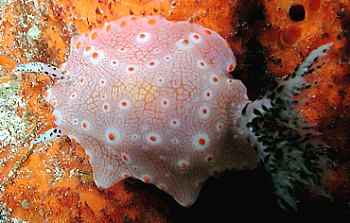
Dear Bill,
The photos in this Forum helped me to identify this little beauty as Halgerda batangas. It was sitting on a orange sponge (?) and didn't move. Maybe it was feeding ?
Length: ~4cm
Depth: ~13m
Location: Pulau Pisan, Horseshoe Bay, Rinca, Indonesia
Date/Time: 29. Sept. 2001, around 15:00
Regards,
Sabine
dive@snoack.de
Noack, S., 2002 (Sep 19) Halgerda batangas from Indonesia. [Message in] Sea Slug Forum. Australian Museum, Sydney. Available from http://www.seaslugforum.net/find/7919Thanks Sabine,
It could be very well be feeding on the sponge. We know so little about what these animals feed on that any information is useful. If you suspect and animal is feeding on a sponge or simiar colony one fairly unobtrusive way of checking is to gently lift the head end and see if there is a fleshy 'tube' connecting the slug to the sponge. Most species feed by everting a proboscis or oral tube so the mouth parts can get to the sponge. Jun Imamoto's recent series of photos showing Hypselodoris festiva feeding will give you an idea what to look out for.
Best wishes,
Bill Rudman
Halgerda batangas from Malaysia.
September 11, 2002
From: Richard Houghton
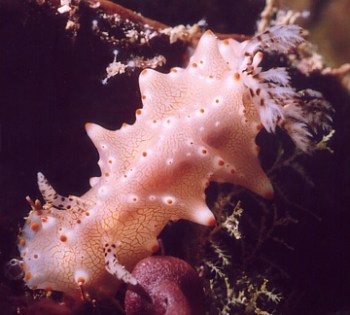
Dear Bill,
I believe this nudibranch is Halgerda malesso. Found travelling across a sponge on a reef slope at around 10 metres, off Mabul Island, Malaysia in August 2002.
At another site about 1 mile away we also found two on the sea floor within 2 metres of each other.
Best regards,
Rich
richard_houghton@hotmail.com
Houghton, R., 2002 (Sep 11) Halgerda batangas from Malaysia.. [Message in] Sea Slug Forum. Australian Museum, Sydney. Available from http://www.seaslugforum.net/find/7848Thanks Rich,
It is similar to H. malesso but is in fact Halgerda batangas. Have a look at the Fact Sheet for a discussion on how to distinguish them.
Cheers,
Bill Rudman
Halgerda batangas from nth Sulawesi
July 5, 2002
From: Helmut Schirmböck
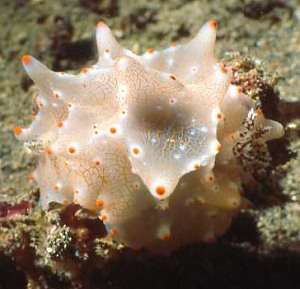
Dear Bill,
Here is another slug from the Bunaken Is - Lembeh Strait region of Nth Sulawesi, Indonesia.
Regards,
Helmut.
schirmis@aon.at
Schirmböck, H. , 2002 (Jul 5) Halgerda batangas from nth Sulawesi. [Message in] Sea Slug Forum. Australian Museum, Sydney. Available from http://www.seaslugforum.net/find/7422Dear Helmut,
This is Halgerda batangas.
Best wishes,
Bill Rudman
Re: Halgerda batangas? from Sulawesi
October 5, 2001
From: Shireen Fahey
Hi Bill,
I just saw the 20 Sept. message from Mary Jane re: Halgerda batangas. It certainly has all the features of H. batangas: a white circle under the red-orange capped tubercles, orange network between the tubercles, dark spots on the gill and rhinophores and no dark posterior line on the rhinophores. Halgerda malesso would have had two or more fine orange lines along the mantle margin.
For those interested in the genus Halgerda, I have two new publications out that have comparisons between these two species and others. Check out The Bollettino Malacologico, 37(5-8): 55-76 and Zoologica Scripta, 30(3): 199-213. The editors did a great job on the colored photos.
All the best Bill,
Shireen
sfahey@mailbox.uq.edu.au
Fahey, S., 2001 (Oct 5) Re: Halgerda batangas? from Sulawesi. [Message in] Sea Slug Forum. Australian Museum, Sydney. Available from http://www.seaslugforum.net/find/5384Thanks Shireen,
I should have made it clearer in my remarks on Mary Jane's messagethat I didn't think her animal was either H. malesso or H. batangas as I couldn't see any indication of a reticulate pattern of orange - only the orange lines on the tubercles. Perhaps it is like Mary Jane's earlier photos from the Solomons, where the reticulation is only present on the outer part of the mantle skirt whcih is not visible in this dorsal view.
Best wishes,
Bill Rudman
Halgerda batangas? from Sulawesi
September 20, 2001
From: Mary Jane Adams
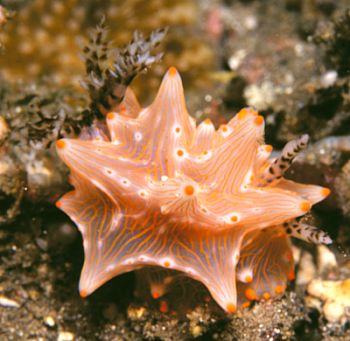
Hi Bill,
I think this is Halgerda batangas. I found it on a night dive. Length: 30 mm, Depth: 10 meters.
Divesite: Hairball too, Lembeh Straits, Sulawesi, Indonesia, Aug. 11, 200l.
Best regards,
Mary Jane
divepng@yahoo.com
Adams, M.J., 2001 (Sep 20) Halgerda batangas? from Sulawesi. [Message in] Sea Slug Forum. Australian Museum, Sydney. Available from http://www.seaslugforum.net/find/5192Dear Mary Jane,
Thanks for this photo. I don't think this is Halgerda batangas which has a reticulate pattern of orange on the mantle, rather than a series of lines. I have a feeling I have seen this before. Perhaps Shireen Fahey can give us a clue,
Bill Rudman
Halgerda batangas? from Papua New Guinea
February 1, 2001
From: John Chuk
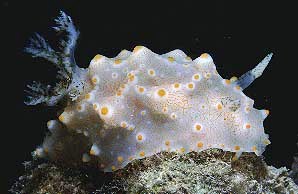
Dear Bill,
In my collection I found this picture of what I think may be Halgerda batangas.
The photo was taken in Kieta Harbour, Bougainville Island, P.N.G. on 3/11/89. Several specimens were found in close proximity, hidden in ledges, on the reef flat at a depth of 2m.
I'd be grateful if you could confirm the identity.
Thanks again for the work you put into an excellent website!
John Chuk
jchuk@giant.net.au
Chuk, J., 2001 (Feb 1) Halgerda batangas? from Papua New Guinea. [Message in] Sea Slug Forum. Australian Museum, Sydney. Available from http://www.seaslugforum.net/find/3646Dear John,
I think this is H. batangas but I have a bit of a problem clearly seeing the nature of the orange colour pattern on the mantle. If it is a network of thin lines then it is almost certainly H. batangas. However if they are spots then you probably have H. carlsoni
Best wishes,
Bill Rudman
Halgerda batangas & H. carlsoni from Solomon Ids
January 3, 2001
From: Bruce Potter
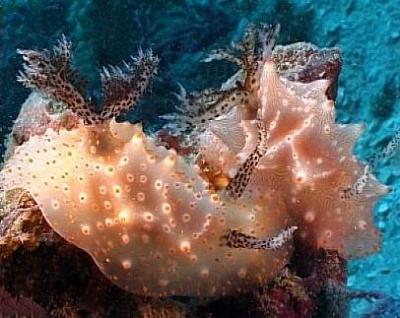
Dear Bill,
When I came back from a christmas dive trip, I read Mary Jane's message about Halgerda batangas. I went home and checked what I had on file and discovered that I had H. batangas listed as Halgerda carlsoni.
I took the afternoon off, and visited the site that I frequently find Halgerda. In an area of about 10 square feet I found three Halgerda's. Two were what I now believe to be H. batangas, while the other was a H. carlsoni. The gills and rinophores of the H. carlsoni were much darker than the >H. batangas. Both had a yellow line around the foot. They were at about 16 meters, on rubble. They were all about 40mm in length. I have included photos of the two separately, and one of them together.
They showed no interest in each other.
Regards
Bruce Potter
bruce.potter@adventist.org.sb
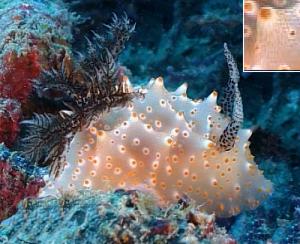
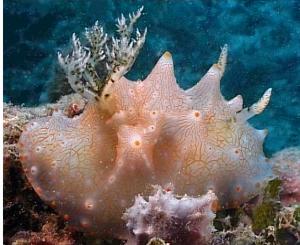
Dear Bruce,
I am glad you can check things out so quickly after they appear on the Forum. It would be interesting to check out the animal you are identifying as H. carlsoni {lower left photo) as it usually has quite distinct small orange spots scattered all over the mantle. These are difficult to see in your photo and appear (see inset) to be short lins rather than spots. This might be an optical illusion so if you could check it out I woud be grateful.
Best wishes,
Bill Rudman.
Halgerda batangas from the Solomon Ids
December 24, 2000
From: Mary Jane Adams
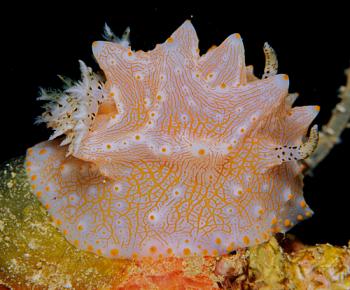
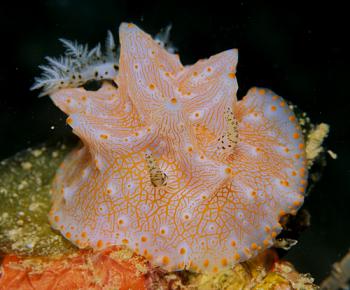
Hi Bill,
This beauty was observed on a barge wreck at Ghavutu Island [Solomon Ids] on several occasions in November 2000. The area is a sand slope below a WWII pier and dumping grounds. I tried to ID it using the images on the Forum. (Your website has become quite a reference source!) The reticulated pattern on the body looks like Halgerda malesso, however the rhinophores look more like Halgerda carlsoni. It was about 5 cm long and 4 cm tall. Depth: 25 meters
Water temp: 84F
What do you think it is?
Thanks,
Mary Jane
divepng@yahoo.com
Adams, M.J., 2000 (Dec 24) Halgerda batangas from the Solomon Ids. [Message in] Sea Slug Forum. Australian Museum, Sydney. Available from http://www.seaslugforum.net/find/3412Dear Mary Jane,
I'm pretty sure this is Halgerda batangas, which was only named in the last few months.
You will see a comparison of it and similarly coloured species at the top of this page. Your find certainly increases the known geographic distribution of the species.
Best wishes,
Bill Rudman.
Halgerda sp. 1. from the Philippines
March 3, 2000
From: Bernard Picton
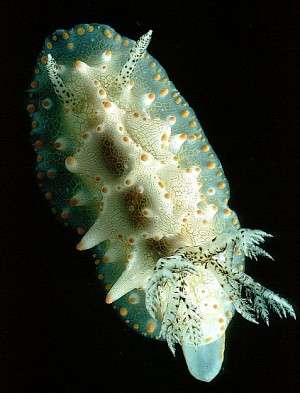
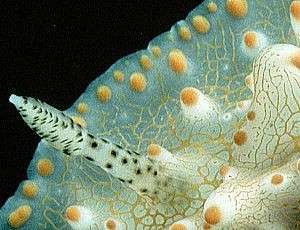
Hello Bill,
It's good to see the Forum moving from strength to strength - I keep using it as an example to people here of a perfect website for species biology! I wish I had more time to get involved.
I was looking at your Halgerda pictures and would like some feedback on the
enclosed, as well as providing some more details of distribution and a couple of close-up pictures for some species. I've been confused for many years by the species I've found so to see that Shireen Fahey is now working on some gives me heart!
Firstly Halgerda malesso and your Halgerda sp.1. - Indeed I've been seeing Halgerda sp.1. regularly in Indonesia and first in the Philippines in 1983 - pictures enclosed. As Carlson says in the Forum it has no line at the edge but a row of yellow tubercles there (see close-up) as well as the reticulate yellow pattern. I think I have also seen a specimen without the reticulation or spots but I'll have to hunt out the picture.
[NOTE: Bernard has sent photos & notes on four other species of Halgerda which I will post separately over the next few days - Bill Rudman].
Best wishes,
Bernard
bernard.picton.um@nics.gov.uk
Picton, B., 2000 (Mar 3) Halgerda sp. 1. from the Philippines. [Message in] Sea Slug Forum. Australian Museum, Sydney. Available from http://www.seaslugforum.net/find/2011Dear Bernard,
Thanks for the comments about the Forum - but 'perfect' may be going a bit far!
It's great to see the work on Halgerda starting to appear. I'm just about to change Halgerda sp. 2. to Halgerda stricklandi and Atsushi Ono has just sent a photo of an interesting species from Japan.
Best wishes,
Bill Rudman.
Re: Halgerda sp. 1. from the Philippines
March 3, 2000
From: C Carlson & P J Hoff
If the presses don't break down, Halgerda sp. 1. will have a name next month.
Clay & Patty Jo
ccarlson@kuentos.guam.net
Carlson, C. & Hoff, P.J., 2000 (Mar 3) Re: Halgerda sp. 1. from the Philippines. [Message in] Sea Slug Forum. Australian Museum, Sydney. Available from http://www.seaslugforum.net/find/2021Halgerda sp. 1 from Great Barrier Reef
May 8, 1999
From: Jacquie Sheils
After giving up in confusion, I was happy to find a photo of Halgerda sp.1 on your website, many books seem to be rather confused about which Halgerda is which, and as a result so am I.
The 2nd photo, which was from the Phillipines I think, looks just like the one we see at Hardy Reef, about 80km NE of the Whitsundays, I am basing this on the fine, spidery network of orange lines between the tubercles. We also regularly see Halgerda aurantiomaculata.
Jacquie Sheils.
jsheils@mackay.net.au
Sheils, J., 1999 (May 8) Halgerda sp. 1 from Great Barrier Reef. [Message in] Sea Slug Forum. Australian Museum, Sydney. Available from http://www.seaslugforum.net/find/828Dear Jaquie,
I am not sure if that species has been found on the Great Barrier Reef. There are still more unnamed species of Halgerda to be described, and when I get a chance I'll put some more photos on the site. If you can possibly get photos of any of the species you are unsure of I am happy to have alook at them and put the on the Sea Slug Forum. If you don't have scanning facilities I can scan slides or prints here and return them to you.
Best wishes,
Bill Rudman.
Comparing Halgerda carlsoni & H.malesso
February 3, 1999
From: Erwin Koehler
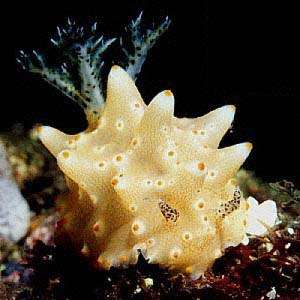
Dear Bill,
Some days ago I sent a photo of Halgerda malesso to you, (Housereef, Lipayo, Negros Is., Philippines, Nov. 1998) identified according Deblius' book, but now I found several photos at WWW looking similar to mine, which are identified as H. carlsoni. Can you bring some light into my darkness and tell the differences between those similar looking species?
I don't want to get on your nerves, I'm very glad that I've found someone who answers to my questions...2 years ago I was a diver with a camera, who loved nudibranchs, nothing more. Now I think I know quite a lot more, I own several scientific books (but it's hard to understand them). I try to indentify the slugs on my photos by the pictures in these books, sometimes I try to understand the text (English/Latin is difficult, other languages are impossible).
Now to Halgerda:
In Debelius' book is a photo of H. carlsoni (black rhinopores, almost no orange ornaments), the same specimen (another photo) is in Clay Bryce's book. Other photos of H. carlsoni at http://siolibrary.ucsd.edu/slugsite/phil/carlsoni.html and at http://www.oz.net/~jrosenf/carlsoni28_nudis1.html are looking exactly like H. malesso at Debelius' book.
The photo of H. carlsoni at http://siolibrary.ucsd.edu/slugsite/nudiwkps/nudiwk1.html points to the top of my confusion - rhinopores like H. carlsoni and ornaments like H. malesso in Debelius' book.
Erwin
E.Koehler@deutschepost.de
Koehler, E., 1999 (Feb 3) Comparing Halgerda carlsoni & H.malesso. [Message in] Sea Slug Forum. Australian Museum, Sydney. Available from http://www.seaslugforum.net/find/533Dear Erwin,
Sorry I didn't post your pic earlier but I happily had too much to deal with all at once. Don't worry about sending questions etc. If I didn't want to answer them I wouldn't have started the website.
The orange and white species of Halgerda are confusing and I suspect there is more of the story yet to tell. The basic difference between H. carlsoni and H. malesso is that the first has a background of fine orange specks and the second a network of orange lines. The first two pictures you refer to:
http://siolibrary.ucsd.edu/slugsite/phil/carlsoni.html and http://www.oz.net/~jrosenf/carlsoni28_nudis1.html
are not H. carlsoni (even though they are labelled as such), but H. malesso.
The third picture at http://siolibrary.ucsd.edu/slugsite/nudiwkps/nudiwk1.html is probably H. carlsoni but I haven't seen a specimen with a solid orange mantle border before. It is like the border of Halgerda aurantiomaculata.
This doesn't totally solve your problem but I think it is the orange pattern, rather than the rhinophore and gill patterns which are important. It is possible that the uniform blackish colour of the gills and rhinophores of the last picture indicates it is a different species, but it may just be an aberrant colour form.
Best wishes,
Bill Rudman.
PS: See Clay Carlson's February 5, 1999 message comparing this species with the real H. malesso.
Rudman, W.B., 1999 (Feb 3). Comment on Comparing Halgerda carlsoni & H.malesso by Erwin Koehler. [Message in] Sea Slug Forum. Australian Museum, Sydney. Available from http://www.seaslugforum.net/find/533